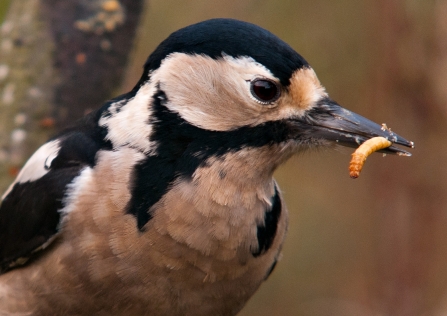
Credit: Bob Coyle
Whilst they are prevalent as far as Japan and North Africa – they are not found in Ireland or the far north of Scotland.
Their characteristic tapping is known as drumming and each species has a distinctive drum roll that varies with the number of drums, rhythm and speed per roll. It is a form of communication, thought to be territorial. The short bursts are also useful for making sure their brain doesn’t overheat as they are capable of 20 pecks per second, averaging 10-11,000 per day!
The woodpecker skull has a remarkable structure to protect the brain from the impact of all that pecking, their skulls are reinforced, structured to spread the impact force, and their brains are tightly cushioned and protected from repeated impacts. And to avoid inhaling wood dust they have special feathers that look like bristles on their nostrils.
Woodpeckers excavate their own nests in tree trunk cavities and are monogamous, though outside of breeding season (Mar-May) they are generally solitary birds with a limited vocal range producing calls and trills rather than song. They have 1 clutch of 2-5 eggs a year. Their eggs are easily identifiable as they are white so the parents can see them in the dark tree cavities, and of course the cavities make camouflage unnecessary.
Opportunistic omnivores, woodpeckers forage for insects on tree trunks but will supplement their diet with eggs and flowers, they have long sticky tongues to search tree crevices for any hidden insects. Green woodpeckers especially enjoy ants so can often be seen pecking on grass looking for their favourite treat.
Woodpeckers also have a distinctive flight pattern, three wing flaps followed by a glide, making it fun to look out for them in the skies as well as in trees.
They can live 4-12 years in the wild but their biggest threat is habitat loss through urban development as their homes are generally in wooded areas. This is why the work we do in enhancing and creating woodland is so important, along with making sure we encourage insects and pollinators for woodpeckers and other birds to eat by creating wildflower meadows across the region.
